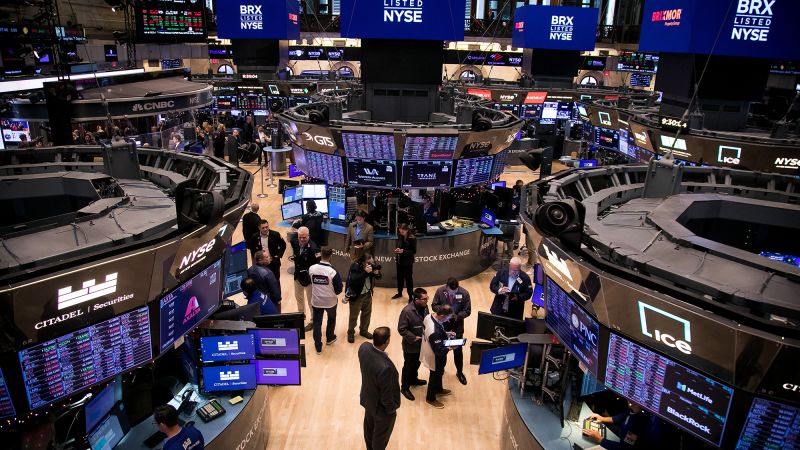This year’s stock rally is back on course, but not everyone is on board.
The S&P 500 index in November notched its best monthly performance this year, snapping a three-month streak of steep losses as Wall Street became optimistic that the Federal Reserve is done raising interest rates. The revival in stocks, though off to a bumpy start in December, has been broad in reach, pulling up shares of everything from small caps to cyclical stocks.
Among the chief catalysts for the rally are swooning US Treasury yields. The yield on the 10-year US Treasury note fell to 4.12% on Wednesday, well below the 5% it topped in late October, according to Tradeweb.
The glut of cash on the sidelines is “poised to fuel a significant rally in risk assets, offering investors an opportunity to potentially capitalize on improved sentiment and market dynamics,” wrote Seema Shah, chief global strategist at Principal Asset Management, in a note on Monday.
But analysts say that retail traders aren’t jumping into the stock market and might not anytime soon. Cash is still king for many.
The TD Ameritrade Investor Movement index for November, a measure of retail investor sentiment, revealed that the company’s clients were net sellers of stocks last month despite the market’s recovery. The index also recorded its lowest monthly reading since May.
“A lot of retail investors are just happy to not participate right now,” said Brian Mulberry, client portfolio manager at Zacks Investment Management.
There is a record $5.84 trillion parked in money market funds as of November 29, according to Investment Company Institute data. About $2.25 trillion of that cash is in retail money market funds.
While institutional investors are starting to pick at stocks poised to do well if the economy reaccelerates — explaining the rally’s widening breadth — retail traders are taking a more conservative approach, especially after seeing steep declines in their portfolios during last year’s sell-off, says Mulberry.
Plus, yields are still at attractive levels compared to recent years, when low interest rates meant that cash offered little return for investors.
Staying out of the stock market action and betting instead on fixed income is paying off for investors. The Bloomberg US Aggregate bond index, a widely-tracked benchmark for the performance of US investment-grade bonds, logged a 4.5% return in November. That’s the index’s best monthly performance since 1985.
“Next year, [we’re] looking at a lot of uncertainty and volatility,” including the Fed’s rate trajectory and concerns about a possible recession, said Mulberry. “I think a lot of retail investors will just continue to sit on the sidelines.”
The sell-off in the oil market accelerated Wednesday, with US crude prices sinking below $70 a barrel for the first time since July, reports my colleague Matt Egan.
The latest wave of selling bodes well for consumers, suggesting gas prices could fall even closer towards $3 a gallon nationally.
Gas prices bottomed out at $3.10 a gallon in late December last year just before Christmas. The national average hasn’t been below $3 since May 2021.
US crude tumbled to as low as $69.11 a barrel on Wednesday, the lowest intraday level since June 29. Oil closed at $69.38 a barrel, down 4.1% on the day. Brent crude, the international benchmark, fell 3.8% to $74.25 a barrel.
Analysts said the sell-off is being driven by a confluence of factors, including concerns about soft demand in China, record-setting supply from the United States and disappointment over last week’s OPEC+ decision.
“The market has fallen off quite rapidly,” said Andy Lipow, president of consulting firm Lipow Oil Associates. “It could really be interpreted as OPEC+ losing its ability to control prices.”
Read more here.
McDonald’s has a burger strategy to spark growth in the next few years. That strategy can be boiled down to one word: More.
“In the US, in a number of markets, around the world, having a larger burger is an opportunity,” CEO Chris Kempczinski told CNN in an interview.
“We’re working on that,” he added. “That is something that you should expect in the future.”
It’s not just more burger in your burger. It’s more everything, reports my colleague Danielle Wiener-Bronner.
The burger chain plans to open thousands more restaurants. It wants to add 100 million members to its loyalty program, which nudges customers into spending more. And it’s investing in more marketing campaigns to get people craving its burgers and fries — and, increasingly, chicken sandwiches, too.
McDonald’s has already been working on a plan to improve how its burger tastes. But it’s learned that in addition to softer buns and gooeyer cheese, people also want a more sizable burger.
“We’ve listened to our customers. And we understand their desire for larger, high-quality burgers that fill you up,” said Jo Sempels, who oversees markets where McDonald’s has licensed its brand, during an investor event on Wednesday.
Read more here.
Read the full article here





